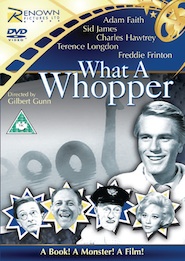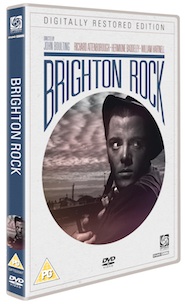One such attempt is 1961’s What a Whopper (Renown Pictures Ltd), a somewhat knockabout comedy with an impressive pedigree: it’s written by Terry Nation, the man who invented the Daleks; the music is by The Avengers’ composer, Laurie Johnson; and the theme song is arranged by the one-and-only John Barry.
Adam Faith stars as Tony, a wide-boy author who writes a book on the Loch Ness Monster and then takes his pals to the Highlands to somehow convince the gullible locals to believe in faked photos.
Chased by the drunk father of his female friend and hounded by the Scottish police (Terry Scott with a very odd accent), Tony must try to stay one step ahead if he’s going to become a success.
The rather lacklustre production is enlivened by appearances by some of the best-known faces in British comedy, who variously help and hinder proceedings: Sid James, Terry Scott, Spike Milligan, Wilfred Bramble and Charles Hawtrey are just some of those who become involved in the plot.
Though it can’t lay claim to being the finest Loch Ness film, nothing making much sense at any point of the proceedings, What a Whopper does its job by entertaining the viewer for the duration of its run time before going on to become pretty much forgettable.
By the mid-1960s the director Michelangelo Antonioni may have been best known for the classic Blowup, but rewind to 1953 and his second film, La signora senza camelie (The Lady Without Camelias) (Masters of Cinema), shows a director already comfortable behind the camera.
The film is set in the world of filmmaking and filmmakers, where a beautiful young starlet, Clara (Lucia Bosé), is introduced to a world of producers, directors and admirers which soons goes awry.
With her new husband against Clara demeaning herself for the camera, the meaning behind her life starts to become unclear and it’s not long before the actress is looking elsewhere for TLC.
Also out now from Masters of Cinema is Antonioni’s Le Amiche (The Girlfriends), a 1955 drama which seems to pre-date Sex and the City by a few decades as a group of women face love, loss and the male sex in Turin.
Both films feature women who are able to decide their own fate but who are also at the mercy of the men around them. Society may have been changing in the 1950s, but the swinging sixties were still a while away and there’s a feeling in both films that if the menfolk would leave them alone for a while things would work out much better for everyone.
Of the two films, La signora senza camelie is perhaps the most accessible for the general audience, and certainly for the movie buffs out there wanting to catch a glimpse behind the facade of 1950s Italian filmmaking.
Seeing behind the facade of the women in Le Amiche is just about possible but it’s a more draining experience, though it can’t be denied that Antonioni’s style is as accessible today as it was then.




